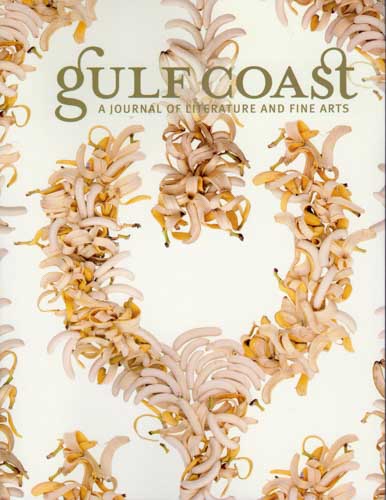Gulf Coast – Summer/Fall 2014
The University of Houston’s Department of English publishes Gulf Coast, a literary journal started by Donald Barthelme and Philip Lopate in 1982, under the Texas-worthy name Domestic Crude. The current name was adopted in 1986; in 2013 the magazine merged with the Texas art journal Art Lies and began to publish writings about art in each issue, as well as the visual art which has always appeared. The list of distinguished contributors to this issue originates far beyond Houston and Texas, although local authors turn up as well.
The University of Houston’s Department of English publishes Gulf Coast, a literary journal started by Donald Barthelme and Philip Lopate in 1982, under the Texas-worthy name Domestic Crude. The current name was adopted in 1986; in 2013 the magazine merged with the Texas art journal Art Lies and began to publish writings about art in each issue, as well as the visual art which has always appeared. The list of distinguished contributors to this issue originates far beyond Houston and Texas, although local authors turn up as well.
This issue of Gulf Coast is a treat for eye, ear, heart, and mind. Fiction is represented by four short stories. Pamela Ryder offers “There’s Nothing Here You’d Want,” a Hemingwayesque evocation of the responsibilities of a daughter whose father slowly fails and then dies. The bad faith of a series of caretakers, the poignancy of the scene in which she talks with her father about his funeral, the anticlimax of cleaning out the empty apartment—each receives a painterly treatment, full of detail, with pain leaking out from between the declarative sentences. The story sticks in memory.
Front and back cover art and a portfolio inside features the fruit-inspired work of David Burns and Austin Young of Los Angeles, who create under the name of Fallen Fruit. Witty, colorful, and conceptual without sacrificing aesthetics, their work uses fruit to reframe the familiar. A couple of helpful pages of text by Legier Biederman introduce the portfolio, which offers variety, humor, and suggestive juxtapositions, such as a sculpted version of The Last Supper with a giant strawberry adorning the table in front of Christ. Photographs by Zineb Sedira and Clarissa Tossin are also represented in this issue, the latter accompanied by an interpretive essay by Mariola V. Alvarez. The writings about art also include Rachel Cook’s piece on the Houston performance art space DiverseWorks, focusing on its 2013 retrospective exhibition The Eleventh Hour. Because Cook was one of two curators of the exhibition, her article here provides some suggestive insights into the curatorial process and the process of discovery experienced by Cook and her co-organizer Elizabeth Dunbar.
The poems in this issue include a group of three by Rodney Koeneke: “after lunch, some poems,” “first there’s his heart destroying the Strega,” and “a ricercar fore frescobaldi.” Koenke has a ravishing way with sound, ravishing enough that the reader willingly foregoes easily accessible meaning and probes beneath the surface of the words. “Strega,” Italian for “witch,” is the name of an Italian liqueur scented with saffron. The second poem, composed of six short stanzas, opens “First there’s my heart / destroying the Strega”; later the poet finds “that the heart is wanton and wanders” before concluding that
Petals are pulled
and after regretted
now finish the Strega,
come cool in the bath.
Without knowing precisely what experience is being referenced, the reader feels some of the uncertainty, ecstasy, and oblivion of physical passion.
Three brief book reviews conclude with Katie Condon’s sensitive reading of Rigoberto González’s poetry collection Unpeopled Eden. She praises González for eschewing the temptation to create imaginary lives for people who died in a plane wreck in 1948, as he elegizes them in the volume’s title poem. The poet lists their names (omitted from contemporaneous newspaper accounts of the tragedy) but does not invent biographical details around which to build his elegy. Instead, Condon observes, he “focuses on their absence,” commanding a deeper participation by the reader in the poetry.
Nonfiction includes a translation from Plutarch, an episodic profile of Georgia O’Keeffe along with two portraits of her by Steiglitz, a moving memoir by Will Boast about writing a novel, and a recollection of teen angst interwoven with a brief life of John the Baptist. The quality of these four pieces alone deliver a delicious surprise for readers.
This issue stands apart from the crowd because of its special features, highlighted by the complete text of the 2013 winning entries for the Barthelme Prize for Short Prose (won by novelist Lawrence Coates). Composition students at the University of Houston, along with their instructor Zachary Martin, editor of the magazine, discuss death penalty narratives. One of the participants in this roundtable discussion is Anthony Graves, now free after 18 years of unjust incarceration. A fascinating multi-part e-mail exchange between Stephen Burt and Maureen N. McLane, on poetry, poetics and criticism, appears without editorial comment, except the acknowledgement that the dialogue took place at the invitation of Gulf Coast.
The magazine enjoys exceptionally high production values, with plentiful full-color artwork and a pleasing heft. Comprehensive masthead information, an accessible editor’s note, a table of contents arranged by genre, and a back-cover listing of contributors by genre make for a reader-friendly experience.
[www.gulfcoastmag.org]





